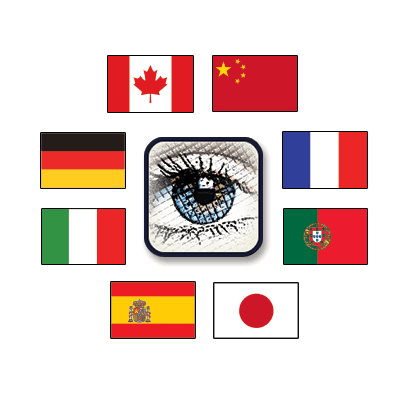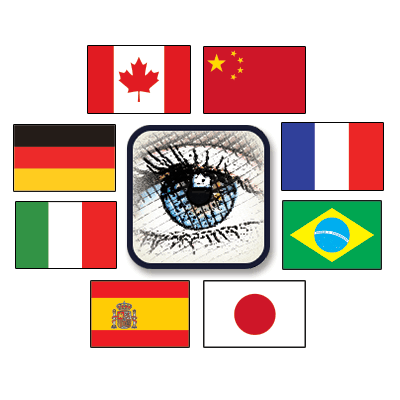
Apple is a big fan of internationalization and localization and encourages developers to translate their apps into many languages. While it’s clearly good to make your apps available to a larger audience, it doesn’t come for free. Localizing and translating your app is hard work, and you want to be sure it will pay off.
In December 2012 we released Etchings 1.5, which includes translations for 7 additional languages: Chinese, French, German, Italian, Japanese, Brazilian Portuguese, and Spanish. It’s been out for a few months now, giving us a chance to reflect on our effort and observe the results.
Getting it Done
The first step to releasing your app in multiple languages is called internationalization (i18n) – making your app ready to handle other languages and region differences. Internationalization is useful even without translation, as it includes things like displaying dates and numbers in formats appropriate to the user’s region. As a camera & filter app, Etchings doesn’t have a lot of text, but we made sure to always use the appropriate system calls to support translated strings.
Once your app is internationalized, it’s time for localization (L10n) – actually translating & customizing the app for specific additional languages & locales. Choosing which languages to translate into is an important decision, and is very much dependent on your app and the markets you are targeting. In some cases it’s as simple as choosing the largest App Store markets first – which was our strategy for Etchings.
Getting the translation done could be a blog post on its own. From our experience, we heartily recommend using a professional translation service, such as one of the companies recommended by Apple. We looked at a number of different providers ranging from self-serve and crowd-sourced systems to firms specializing in Mac and iOS i18n and L10n. In the end we chose to partner with Wordcrafts, a professional service based in Germany. The Wordcrafts team, headed up by Felix Lotze and Oliver Gurtschmann, have a deep understanding of iOS application development as well as the linguistic knowledge needed to create a cohesive translated app.
In addition to translating text appearing in your app, you’ll want to translate your app’s description, keywords, update release notes, and other marketing materials. In fact, it can be cost-effective to only translate those items instead of the app itself. It takes a while to enter everything into iTunes Connect, but this can help a great deal to improve your visibility in App Stores around the world.
It’s important to be aware of the full cost of localization. The first app-wide translation may be the largest single investment, but once you do a translation, you’re committing to that language for the lifetime of your app. This includes translating text for new features and bug fixes, App Store metadata, and future marketing efforts. Language testing will become a permanent part of your QA process. And don’t forget customer support: more and more of your users will be people who do not speak your language, and you will need to find ways to communicate with them.
Reaping the Rewards
We released the Etchings 1.5 update on December 13, 2012. It included the 7 translations mentioned above, as well as several new features like iPad support, high resolution export, and new photo filters.
The update resulted in a nice bump in sales overall, but for the purposes of this article we’re interested in seeing how the increase was affected by the translations. Further complicating the analysis is the fact that Etchings had a worldwide free promotion between December 31st and January 2nd as part of the iTunes 12 Days of Gifts app in emerging markets.
For a relatively clean comparison, we decided to look at Etchings downloads for the 17 days before December 13th, and for the 17 days after and including December 13th. We grouped the downloads by country and then by language (considering the primary language of each country) to see how much downloads increased for each language.
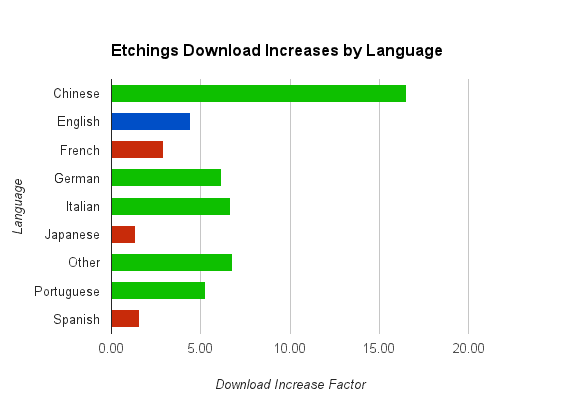
For English countries, downloads of Etchings after the update were 4.44 times higher than before the update. We were pretty happy about that! The data from non-English speaking countries shows some inconsistency. German, Italian, Portuguese, and especially Chinese downloads increased after the update more than English downloads did. However, downloads in French, Japanese, and Spanish countries did not increase as much as English. We also saw a noticeable uptick in downloads from countries that do not speak English or a translated language, especially Russian.
In terms of direct increased sales, it seems that localization was not a slam dunk. It improved sales (compared to English) for some languages, but not for others.
However, there is an important secondary effect to keep in mind. The fact that we translated Etchings was a significant factor in having Apple feature the app in 12 Days of Gifts over the holidays. That promotion generated a tremendous number of free downloads, and pushed paid sales up significantly afterward due to network effects and word of mouth. With localization, your app is more likely to be featured in the countries for which you localize.
Was it worth it?
The immediate payoff may be unclear, but we’ve had some time to observe the overall effect of localization on the revenue of Etchings. The following charts show the revenue share for Etchings before and after the localization update, focusing on English and the translated languages.
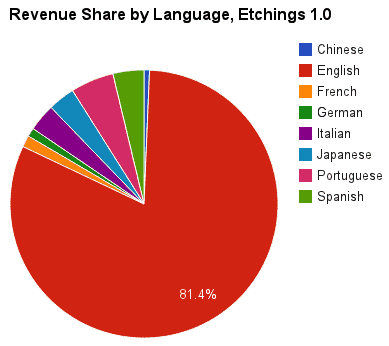
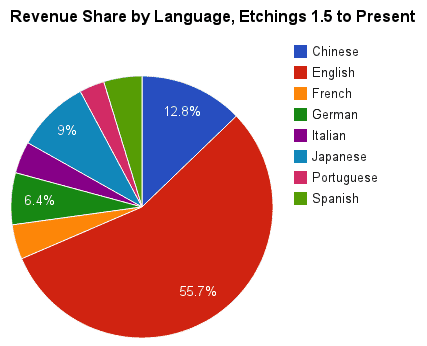
It’s clear that since the update, countries with translated languages have been responsible for a significantly greater share of the revenue compared to English countries. This is an encouraging result and shows that translating the app has had a real and lasting effect.
Our experience has shown that localization does not necessarily come with a huge immediate payoff. For us, localization is a “long tail” effort that has paid off in the long run. We also cannot stress enough how valuable it is for helping your app get featured. Apple’s App Store marketing department looks very fondly on localized apps, so localization is a big factor in getting featured both around the world and in the US.
Next Steps
Etchings 1.6 will include App Store description translations for Russian and Turkish. As we move forward, we’ll continue to monitor sales and determine whether new translations are in order. As mentioned above, localization is an ongoing process and we’ll keep learning as we go. Watch this space for more posts about our adventures in localization!
Check out the discussion on this article at Hacker News.
